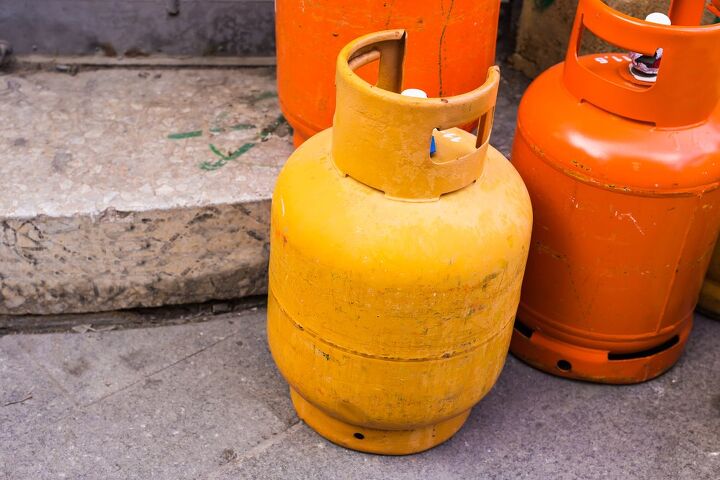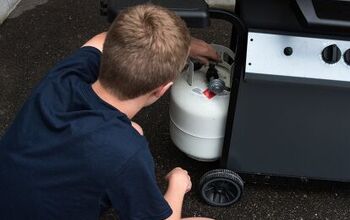What Kind Of Paint Do You Use On A Propane Tank? (Find Out Now!)

Are you tired of looking at your propane tank? Do you wish it could be camouflaged into your landscaping? There’s a simple solution: You can paint it!
To paint a propane tank, always use paint that is specifically designed for metal surfaces and has a rust inhibitor. The paint must be light and heat-reflective; colors like white, light gray, and silver are best. Avoid using dark colors because their high heat absorption can lead to propane expansion and excessive pressure inside the tank.
Do You Need Exterior Home Paint or Stain Services?
Get free, zero-commitment quotes from pro contractors near you.

Why Paint A Propane Tank?
Many people choose to paint their propane tanks. This is typically because they can be an eyesore, especially when you’ve put a lot of effort into your landscaping. Some choose to bury their propane tanks to keep them out of sight. If this isn’t an option, painting a propane tank helps it blend in and be less noticeable.
What Kind Of Paint Can You Use On A Propane Tank?
If you want to paint your propane tank, you can’t just use any sort of paint. You have to choose one that’s designed specifically for use on metal surfaces. There are even some paints that are formulated especially for use with propane tanks.
Be sure to check that the paint you choose includes a rust inhibitor. There’s also another stipulation you’ll need to pay attention to. Propane tanks can only be painted in light, heat-reflective colors. Rustoleum spray paint is frequently recommended as one of the best choices for painting your propane tank.
In some extremely cold climates, you may be able to choose colors that aren’t light and heat-reflective. It’s best to check rules at the state and local levels before proceeding.
Some of the most common colors for propane tanks are silver, light gray, and white. However, beige or pastel colors may be allowed in some areas. Contact your propane supplier if you plan on using a less common paint color for your propane tank.
Why Are Dark Colors Problematic For Propane Tanks?
There’s a reason why dark colors can be problematic and even dangerous for propane tanks. This has to do with the way that dark colors absorb heat, while light colors reflect it.
If you paint your propane tank a dark color like navy blue or black, it’ll absorb a lot more heat. When the propane in the tank heats up as a result, pressure begins to build.
Propane expands and contracts in response to temperature fluctuations. As pressure builds in the tank due to the heat absorbed by the dark paint, the propane begins to expand.
As you can imagine, propane expansion inside the tank can be dangerous! It comes with a risk of combustion. That’s why you should never paint your propane tank a dark color.
How To Paint A Propane Tank
Now that you know what type of paint to use, we’ll cover the process of painting your propane tank step-by-step.
Step 1: Remove The Rust
The first thing you’ll want to do before getting out your paint is to remove the rust. You’ll need either sandpaper or a wire brush to do this. Simply use the tool of your choice to scrub the rust off of the surface of the propane tank.
You can pressure wash your tank rather than scraping the rust off if you prefer. This may be helpful for rust that’s especially stubborn and difficult to remove. If your tank is exceptionally rusty and you can’t remove all of the rust yourself, contact your propane supplier.
Step 2: Clean The Surface
Once the surface of the propane tank is totally smooth and rust-free, it’s time to clean it. Use water and dish soap to remove grease and clean the tank. Rinse it with clean water, and then dry the propane tank.
Step 3: Prep The Propane Tank
At this point, your propane tank should be clean, dry, and free of rust. To prepare the tank for paint, use painter’s tape to mark off any areas you want to avoid. This will likely include the data tag area since it contains important information about your propane tank.
Next, apply a primer to the propane tank. You can find primers specifically made for propane tanks at your local hardware store. A white or off-white primer is best.
You can use a brush, roller, or sprayer to apply the primer to the propane tank. Work with a side-to-side technique to evenly cover the entire surface with primer. Let it dry completely before moving on to the next step.
Step 4: Paint The Propane Tank
It’s finally time for the fun part: painting the propane tank! As with the primer, you can use a brush, roller, or sprayer to paint the tank. Use the same side-to-side technique for an even coat of paint on the surface of the tank. Allow it to dry completely before applying a second coat if you need one.
If you want to be more creative than painting your propane tank in one shade, you can add more detail. Customize the tank with lettering or images, or use a stencil to create a fun pattern. As long as you stick to light shades of heat-reflective paint with a rust inhibitor, you have creative freedom!
Do You Need Exterior Home Paint or Stain Services?
Get free, zero-commitment quotes from pro contractors near you.

Related Questions
Is painting a propane tank safe?
There are some safety concerns when painting a propane tank. This mainly has to do with the paint type and color. You’ll need to make sure the paint is specially formulated for metal so that it doesn’t rust.
In addition, the paint should be light in color and heat-reflective. Dark colors absorb more light, heating up the propane in the tank and increasing the pressure as the gas expands. This can lead to combustion and other issues.
Is propane lighter than air?
Propane vapor is heavier than air, but it is lighter than water. Because propane in its gaseous state is heavier than air, it can accumulate in low-lying areas like basements.
Is propane a fossil fuel?
Yes, propane is a fossil fuel. It is also a “green fuel” because it’s not harmful to the environment.

With a lifelong passion for writing plus strong enthusiasm for home improvement and DIY projects, joining the team at Upgraded Home was an easy choice. Jessica Allen likes to share helpful information with current and aspiring homeowners. Aside from writing, Jessica loves doing yoga, playing the piano, and dabbling in graphic design.
More by Jessica Allen




















![12 Washing Machine Brands to Avoid [with Recall Data]](https://cdn-fastly.upgradedhome.com/media/2023/07/31/9075781/12-washing-machine-brands-to-avoid-with-recall-data.jpg?size=350x220)






